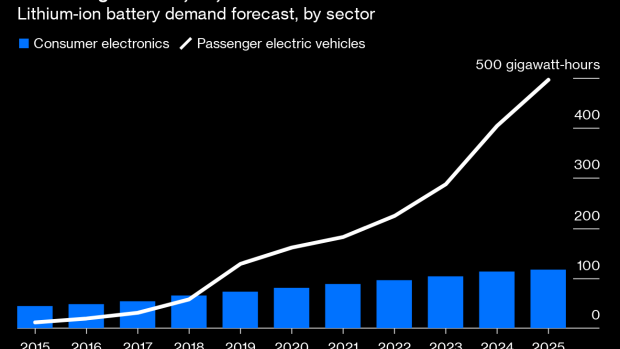Oct 11, 2019
How a Battery Can Lead a Quiet Revolution
, Bloomberg News

(Bloomberg Opinion) -- This week, the Nobel Prize in chemistry was awarded to John Goodenough, Stanley Whittingham and Akira Yoshino for their work developing the lithium-ion battery. The Royal Swedish Academy of Sciences, in announcing the award, said the three men “created a rechargeable world.” The ubiquitous battery is now found in items as varied as hearing aids and power grids. It is a testament not just to technological revolutions, but also to the power of advancements in performance and decreases in cost.
Whittingham began working on the lithium-ion battery in an Exxon Mobil Corp. laboratory in the 1970s, when it was being considered for automotive applications. The lithium-ion battery wasn’t a fit for cars then, but research and development continued and the technology improved, to the point that it became a viable power source in search of an application. But it was Sony Corp., not Exxon Mobil, that would introduce the first lithium-ion battery for consumers. That new device in need of a suitable power source? The handheld 8 mm camcorder.
In 1995, camcorders created the biggest source of demand for lithium-ion batteries. By 2000, laptops had become the biggest driver of demand; by 2005, it was feature phones. By 2010, the smartphone was the biggest source of demand for lithium-ion batteries.
As this rather dramatic chart shows, passenger electric vehicles have vaulted past consumer electronics to become the single biggest source of demand for lithium-ion batteries, less than 15 years after Martin Eberhard built the first Tesla Roadster battery pack from 6,831 of the lithium-ion cells used in laptop computers.
The lithium-ion battery has come a very long way in other ways, too. Battery costs have come down by more than 80% in nine years.
And battery manufacturing capacity has increased more than 200-fold in 15 years.
There is far more expansion planned. Next year will see more new capacity added than the global manufacturing capacity’s total in 2016. By 2023, total capacity will have more than doubled.
The combination of cost, capacity and capability has in itself created a new market for the lithium-ion battery: energy storage within power grids. We need look no further than northern Indiana, where power utility Nipsco plans to replace coal-fired power with wind, solar and solar-plus-storage projects.
The Royal Swedish Academy of Sciences concluded its announcement of this year’s chemistry prize rather poetically: “Lithium-ion batteries have revolutionized our lives since they first entered the market in 1991,” the academy said. “They have laid the foundation of a wireless, fossil fuel-free society, and are of the greatest benefit to humankind.” Sometimes being good enough is revolutionary, too.
Weekend reading
- Some of 2019’s wackiest investment predictions are coming true.
- “Firms that align their business models to a net zero world will be rewarded handsomely,” Bank of England Governor Mark Carney said in a speech in Tokyo this week. “Those that fail to adapt will cease to exist.”
- Carbon Tracker estimates that Japan’s coal-fired power generation fleet could end up as $71 billion of stranded assets.
- Singapore’s Temasek Holdings Pte has decided against investing in Saudi Aramco’s initial public offering, in part over environmental concerns.
- Unilever says that it will reduce its use of virgin plastic by 50% by 2025, and reduce its absolute use of plastic packaging by 100,000 metric tons.
- A new Organization for Economic Cooperation and Development study finds that obesity-related diseases will claim more than 90 million lives in the next 30 years, lower life expectancy by three years, and reduce gross domestic product by 3.3% in OECD countries.
- Three out of 10 low-income Americans do not have access to broadband of any kind.
- In the latest “Stephanomics” podcast, Bloomberg Economics’ Stephanie Flanders explores why birthrates are so low, and what those low birthrates mean for the global economy.
- Arkansas’s Ouachita Electric Cooperative Corp. is seeking a 4.5% decrease in its electricity rates, thanks to its solar power assets.
- Northrop Grumman Corp. has launched the Mission Extension Vehicle-1, the first satellite designed to service and extend the life of other satellites.
- Dyson Group Plc has pulled the plug on its electric vehicle plans, saying “we simply cannot make it commercially viable.”
- The most detailed map of U.S. automobile emissions.
Get Sparklines delivered to your inbox. Sign up here. And subscribe to Bloomberg All Access and get much, much more. You’ll receive our unmatched global news coverage and two in-depth daily newsletters, the Bloomberg Open and the Bloomberg Close.
To contact the author of this story: Nathaniel Bullard at nbullard@bloomberg.net
To contact the editor responsible for this story: Brooke Sample at bsample1@bloomberg.net
This column does not necessarily reflect the opinion of the editorial board or Bloomberg LP and its owners.
Nathaniel Bullard is a BloombergNEF energy analyst, covering technology and business model innovation and system-wide resource transitions.
©2019 Bloomberg L.P.





